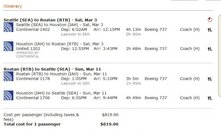DeputyDan
Contributor
Prices are always out of line when you bring a hub into play.
Welcome to ScubaBoard, the world's largest scuba diving community. Registration is not required to read the forums, but we encourage you to join. Joining has its benefits and enables you to participate in the discussions.
Benefits of registering include
WTF!!!!
I just moved to San Antonio Texas from Southern California. I figured air to Roatan should be much cheaper now. What I found is that logic plays no part in airline prices.
Other than on a trip on Taca that took us from LAX through San Salvador, Tegucigalpa, La Cieba on to Roatan, we always fly Continental. With Continental we always have a layover in Houston (and usually miss our connection home).
We lived near Orange County airport. It is a smaller airport so I figured that is why it was usually about $100 more than flying out of LAX. But it was usually worth it to us.
Now we are about 45 minutes air time from Houston (from San Antonio). And this is where things get stupid.
I checked fares recently. I wanted to compare what it cost to fly from here vs. back in California.
From LAX to RTB with a stop in Houston= $618
From SNA (Orange County)= $851
Now, from SAT (San Antonio)= $750!!!
And if I drove the 3 hours to Houston to just fly direct= $670!!!!!
How the hell is it $132 cheaper to fly from LAX to Houston than from San Antonio to Houston!?
WHats more, How can they really charge $52 more to fly straight out of Houston!?!?!?!
From what I can see here is that Continental Airlines will pay you $52 to fly from LAX to Houston.
There has to be something Roatan and/or the diving community can do about this. We don't have many options to get there. By boycotting we just don't get to dive and we hurt Roatan's dive business. Any ideas?
PS: A very special holiday F you to Continental.
Why is it more expensive to go directly from location to location vs. a flight with connections?-(name withheld)
This is a classic airfare question that can be boiled down to a simple enough answer: Supply versus demand. Nonstop routes are a gamble for airlines because they require consistent demand for travel on that exact route.
This isn't usually a problem on popular cross-country routes or for flights to major cities, but on less compelling routes—say, for example, Boston to Indianapolis—demand could be an issue. So if an airline is going to offer nonstop service on a secondary route, it needs to charge more to account for the risk.Connecting routes solve that problem by funneling all that traffic through a hub-and-spoke system. Instead of flying a half-empty plane from Boston to Indianapolis, airlines fly a full plane to Atlanta or Chicago and send the passengers to their connecting flight, where they either join other passengers who've flown into Atlanta and continue to their destination or board a tiny regional jet for a short flight. demand. And instead of flying long-distance routes that necessitate larger aircraft, carriers can fly short routes and use smaller (and subsequently fuller) planes.From a passenger perspective, though, this supply/demand theory is really a simple matter of convenience—and the airlines know it. Nonstop itineraries are shorter overall and less prone to delay or dysfunction, and larger planes tend to be more comfortable and feature better amenities, especially compared to regional jets. You're paying for peace of mind, a better chance of arriving on time and with all your bags, and, in some cases, slightly more space .And this is where the low-cost carriers come in, and where things get more complex.Southwest and JetBlue have perfected the art of point-to-point routing, with largely nonstop routes that crisscross the country all day long. Both make use of hubs or "focus cities," but not to the same degree as traditional hub-and-spoke carriers. More importantly, Southwest pioneered, and others have adopted, the art of the fast turnaround. This allows aircraft to refuel and reboard quickly and continue to another destination. The result is an abundance of nonstop and direct routes (where you don't have to change planes) and a streamlined operation that keeps costs down for the carrier.
The end result is that low-cost carriers often sell nonstop routes for the same price as connecting flights, if not less.By contrast, hub-and-spoke routes have become cumbersome during the ongoing travel slump, especially with the competition from low-cost carriers. Southwest, in particular, has succeeded in connecting smaller cities that were typically routed through a hub—and offering lower prices on better itineraries. So for hub-and-spoke carriers, the system designed to consolidate traffic has turned into a liability because the low-cost carriers can offer a better product, leaving the hub-and-spokes with a lot of dead weight on their route networks. And since changing a route network isn't something airlines can do overnight, the old pricing scheme remains.
Two years ago we flew from Portland Maine to Atlanta to Bonaire for $491. Our daughter was living in Atlanta at the time and I thought we could find cheap flights to Atlanta then spend some time with her then fly on to Bonaire. $491 Portland to Bonaire' $770 Atlanta to Bonaire, that is just retarded, I don't care what kind of excuse anyone comes up with.

From Matrix - ITA SoftwareI was Checking air to Roatan from Seattle. Looks like you can only go with TACA now 2 to 3 stops. 3 years ago we had just 1 stop in Houston then into Roatan all with Continental. Is anyone flying direct to Roatan.


